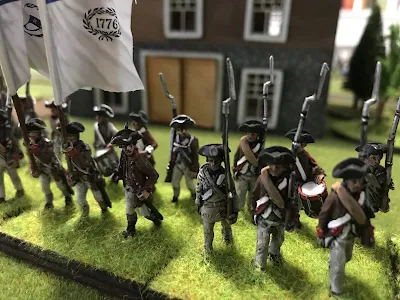Deploying his infantry regiments, the American commander determined to drive off his enemy. While the 1st US Infantry regiment engaged the flank companies and GLI the 5th US Infantry would fight the BIMUC. The 1st Infantry succeeded in driving off the GLI to their front. They then advanced to engage the British flank companies.
But as the 5th Infantry advanced, fate intervened. The Rocket battery for once scored a direct hit! This caused a casualty and a morale check which the Americans failed and felled back shaken.
The American commander brought up another regiment to take the place of the 5th and continued his advance. The British commander had little time to celebrate. His right flank was falling apart and was exposed. And the enemy was bringing up more troops. Not skirmishers but good line infantry. The Incorporated Militia and Artillery would hold, but his flanks were in danger.
The 25th US Infantry charged the Flank companies. Heavily outnumbered the issue was not in doubt. They routed and now the British flank was wide open. On the other flank casualties caused the remaining GLI to also fall back. The American commander now positioned his line to advance against the remaining crown forces.
At this point I called the game. There would be little reason to risk the loss of guns and rockets and one line battalion would not hold against three battalions. It was a great game and a very good scenario which I will play again. On reflection it was error to break up the GLI into two skirmisher groups. The flank companies should have been able to do the job. Also, to advance the Incorporated Militia in line when a column would have gotten into action quicker would have been better. But it is all hindsight, at least untill I play again. This scenario is a real keeper!




























